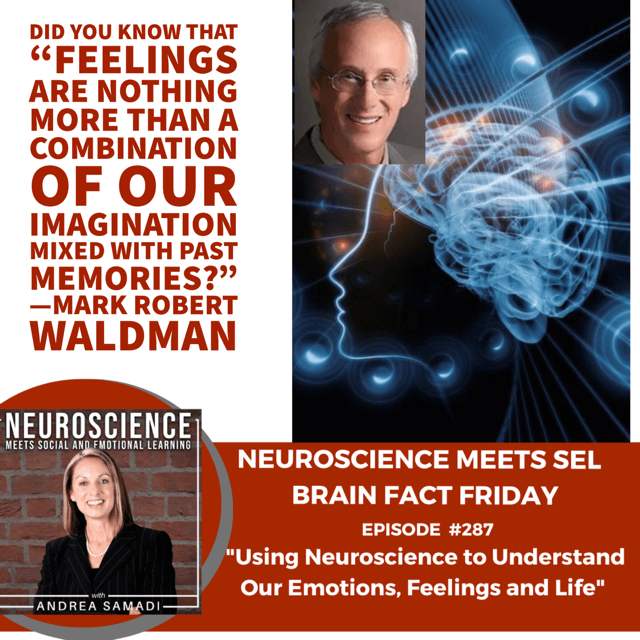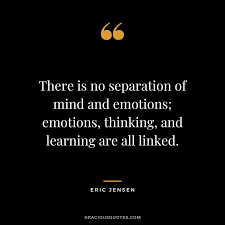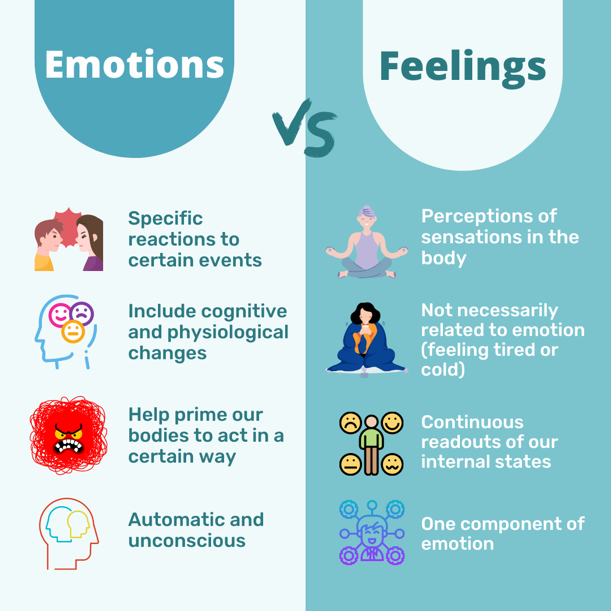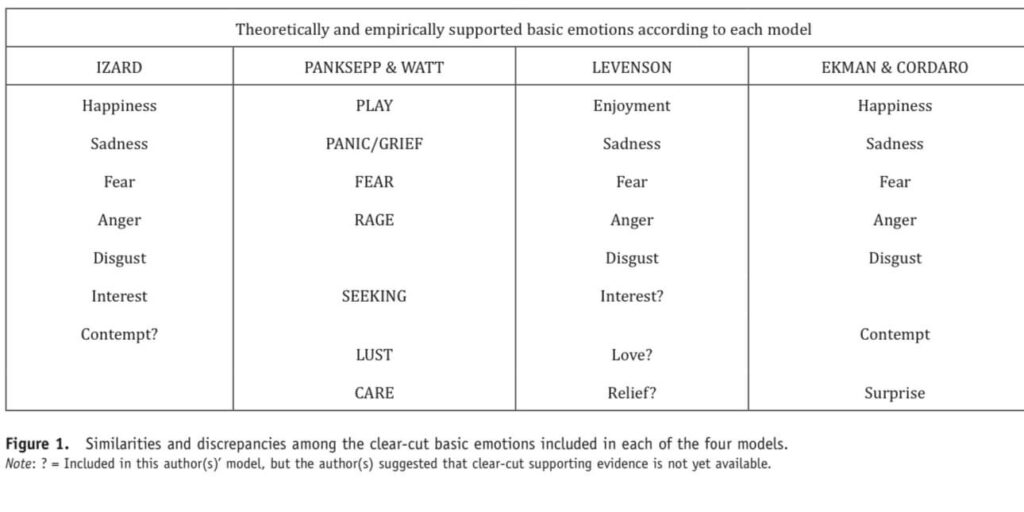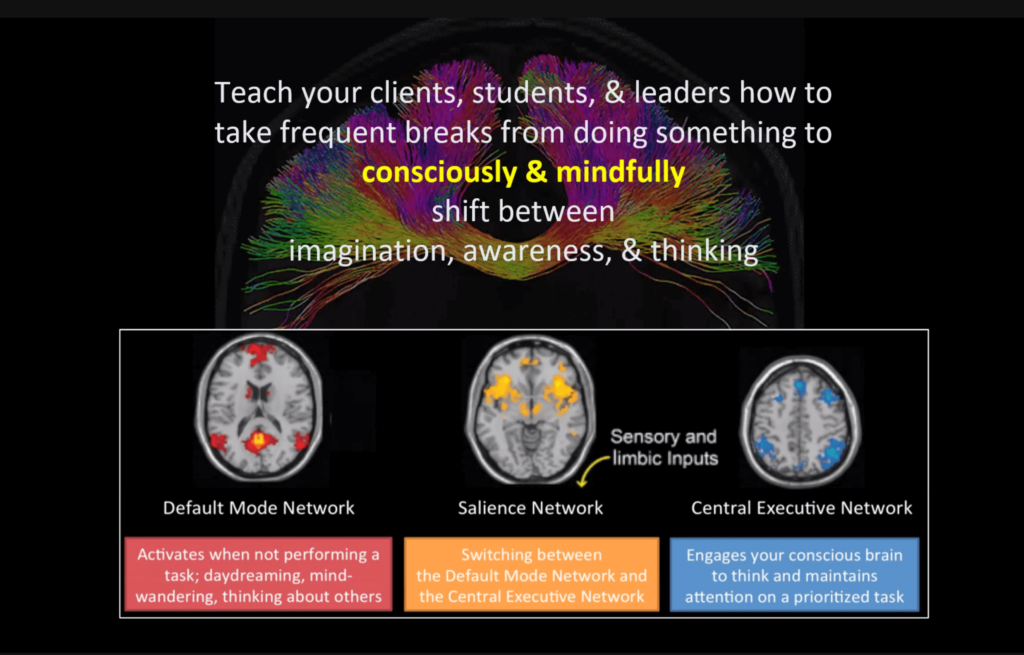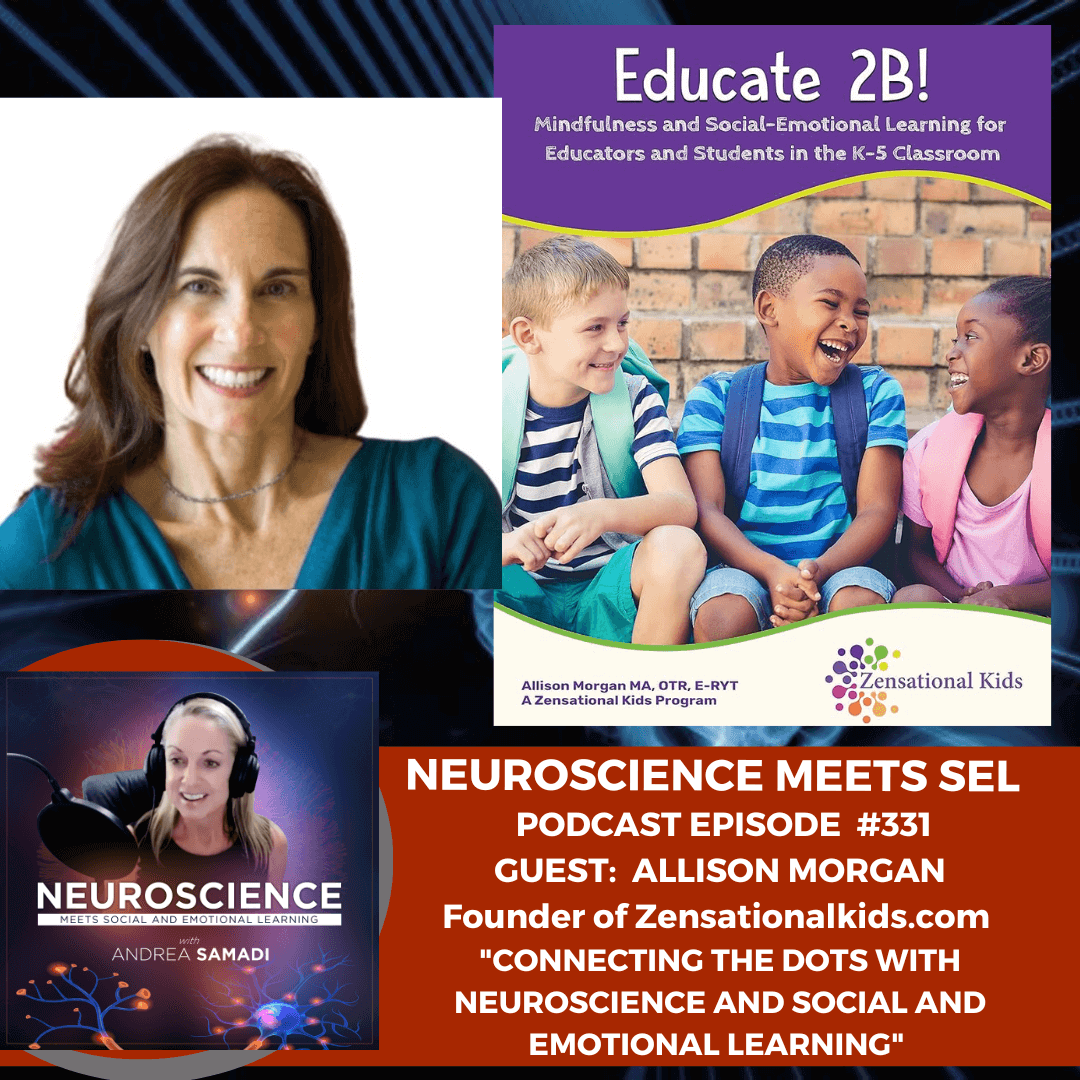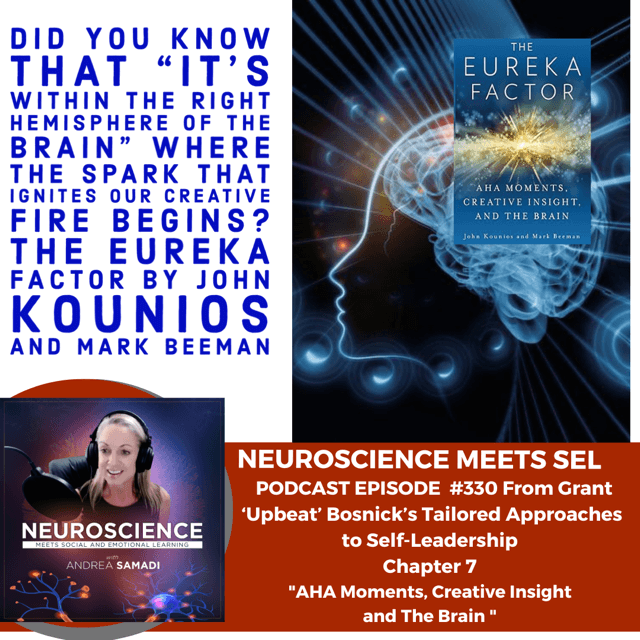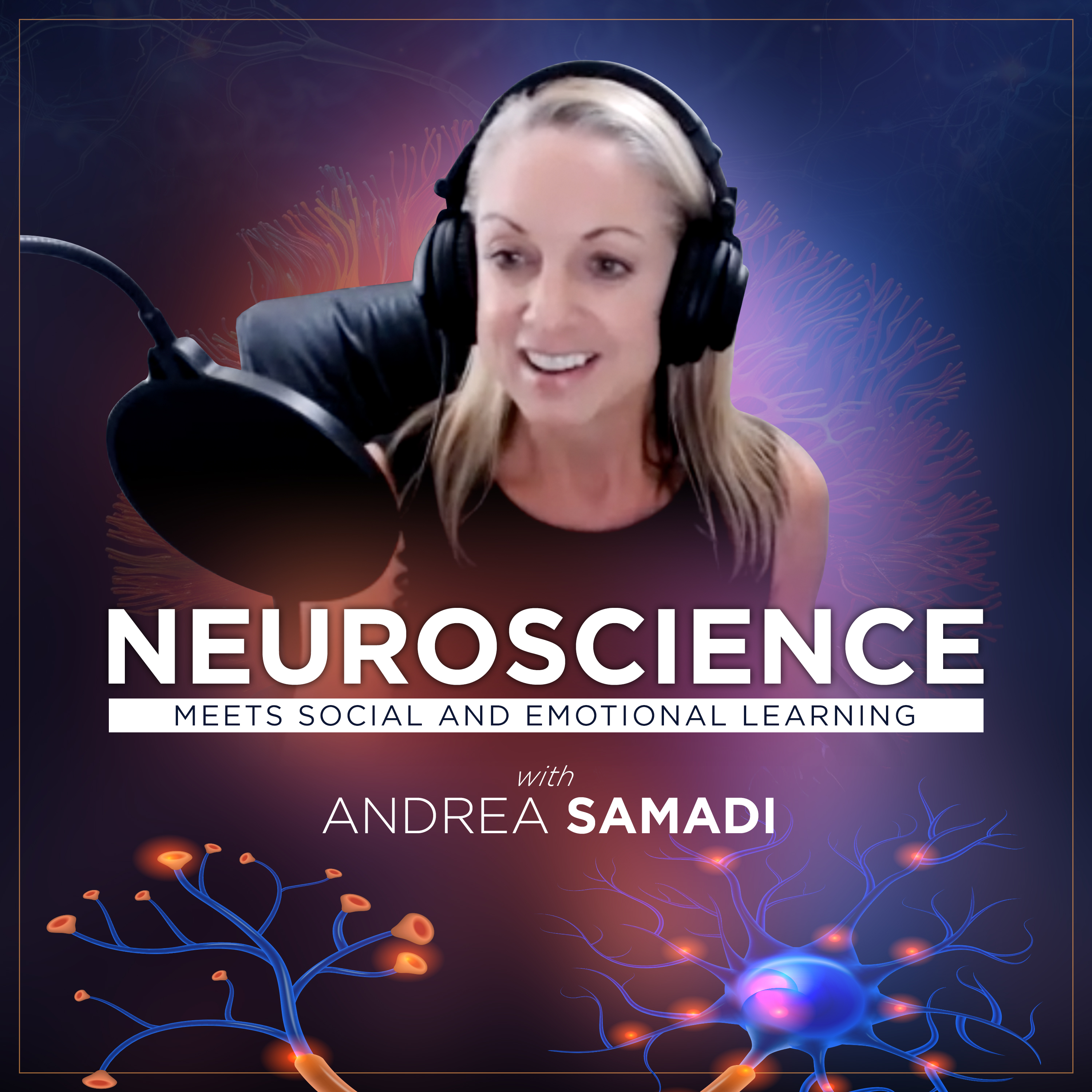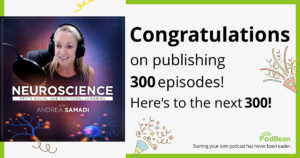“There is no separation of mind and emotions: emotions, thinking and learning are all linked.” Eric Jensen[i]
But what about our feelings? What’s the difference between our emotions and feelings? Have you ever thought about this?
And with that introduction, I want to welcome you back to Season 9 of The Neuroscience Meets Social and Emotional Learning Podcast, where we cover the science-based evidence behind social and emotional learning (for schools) and emotional intelligence training (in the workplace) with tools, ideas and strategies that we can all use for immediate results, with our brain in mind. I’m Andrea Samadi, an author, and an educator with a passion for learning and launched this podcast to share how the understanding of our complex brain transfers into our everyday life and results. Each concept we cover here I’m hoping will help you, wherever you might be listening to this podcast in the world, just as much as these ideas are helping me personally and professionally.
In keeping with our Season theme of “Going Back to the Basics” we look back to EP #127 on “How Emotions Impact Learning, Memory and the Brain.”[ii] It was on this episode, exactly 2 years ago where we first looked at the impact of our emotions on our daily life with the work of neuroscientist Mary Helen Immordino Yang from the University of Southern California. We first met Mary Helen on our 100th EPISODE[iii] and she shared with us that “it is literally neurologically impossible to build memories, engage complex thoughts, or make meaningful decision without emotion.” She further explained that “30 years ago, we had no idea that one could study human emotions that emerge slowly over time—such as admiration and awe—and compare them psychologically and neurobiologically with emotions that emerge more quickly like surprise or fear.” (page 80. Emotions, Learning and the Brain).
Before writing this episode, I had to stop, and think deeply about something I’ve often quoted. I learned this back in my days working in the speaking industry (in the late 1990s) to be careful what you think about because “it’s our thoughts that determine our feelings, that cause us to take certain actions that in turn cause our conditions, circumstances and our environment.” If we are going to look at our emotions today, we need to understand the difference between our emotions, our feelings, and the actions that we end up taking because of them.
Let’s Start with How Emotions Are Different Than Feelings.
I found a clear explanation of “Emotions vs Feelings”[iv] from Dr. David Matsumoto, the founder of Humintell, who explains that emotions “are quick reactions to certain events that may impact our survival. They are unconscious, immediate, involuntary, automatic reactions to things that are important to us” which is right in line with what we learned from Jaak Panksepp’s 7 primal emotions that he mapped out in our brain, and taught us they aren’t something that we can control. They are automatic responses. Dr. Matsumoto further explains that “these reactions include cognitive and physiological changes that help prime our body in a certain way and create sensations in us that we can perceive” which he calls feelings.
You can see a diagram of these differences in the show notes that outlines emotions as “quick reactions to certain events that are automatic and unconscious” and feelings “are perceptions in the body that aren’t necessarily related to the emotion.”[v]
IMAGE SOURCE www.humintell.com Dr. David Matsumoto
Since I’m always looking to connect the most current neuroscience research to improve our best practices, I wonder what can I add to this understanding of our feelings vs our emotions, to see if we can gain a deeper self-awareness into why we feel the way we do, and what this might mean for us, individually, in pursuit of our goals. Or to put this simply, what should we all understand about our emotions, our feelings, and how they translate into our life, and results.
On today’s episode #287 we will explore:
- What are our emotions.
- How are our emotions different from our feelings?
- The debate about emotions in neuroscientific circles looking at Paul Ekman [vi], Carroll Izard, [vii], Jaak Panksepp, [viii] and Robert Levenson’s [ix Theory of Emotions
- Using Brain Network Theory to Understand Our Emotions from an early EPISODE #48[x]
- Other tools, ideas and strategies available to help us to understand our emotions, and feelings.
- Examine: How this understanding can help us take better control of our emotions and feelings, to change the actions that we will take, (so we can stay in better control in difficult situations) thus changing our conditions, circumstances and environment (or our results).
- 3 STEPS for applying this understanding of our emotions and feelings into our daily life.
What Are Our Emotions?
We’ve talked about our emotions with our recent episode with Lucy Biven from EP #270[xi] and Gabrielle Usatynski from EP #282[xii] who both dove deep into the work of Jaak Panksepp who mapped out 7 neurological circuits found in all mammals, and then we made the connection with our emotions and our childhood with an understanding of Bowlby and Ainsworth’s Attachment Theory[xiii]. While I do think we’ve covered Panksepp’s work thoroughly, who’s to say his ideas are correct when philosophers, psychologists, and scientists have been arguing and disagreeing with each other for several thousands of years on this topic.
I had to go back to my notes from the neuroscience certification course I took with Mark Waldman, where he taught us that “even today the debate continues in neuroscientific circles. Paul Ekman[xiv], that you might know as the deception detection expert, or co-discoverer of the micro expression, and the inspiration behind the TV series, Lie to Me[xv], showed evidence that there are 6 universal emotions (fear, anger, joy, sadness, disgust, and surprise). Ekman demonstrated how emotions can all be seen in a person’s brief facial expression, and we covered this fascinating topic on EPISODE #163 with Dan Hill, “The Faces Guy” on “How to read the Emotions in Others”[xvi] but Jaak Panksepp labelled some of Ekman’s universal emotions as secondary emotions, calling them feelings.
Before I get bogged down in terminology, deciphering these arguments, and lost reading this research paper I found on Four Models of Basic Emotions[xvii] I thought an easy way to simplify this concept is to put an image in the show notes that explains the similarities between four models of emotions and make up our own minds with which theory of emotion we resonate with the most. While one will disagree with each another, “all four list a positive emotion labelled happiness (Ekman and Cordaro; Izard), enjoyment (Levenson) or Play (Panksepp and Watt) and three distinct negative emotions, sadness (labeled grief by Panksepp and Watt), fear, (they all agreed on this label) and anger.”[xviii]
Putting Our Emotions into Action
If we want to understand our emotions, we can now begin by thinking about how everyone will respond to these emotions in a different way, since we’ve all had different experiences from childhood and beyond. (Keeping Attachment Theory in mind).
Suppose we were walking through a forest and something jumps out from behind a tree and we instinctively jump (the core emotion of fear that all 4 models agreed with). Then we see it’s a harmless dog, wagging his tail and wanting to play with us. Each person will process this situation in an entirely different way. One person will laugh, another will reach out to play with the dog, while another person will remain upset about the scare for the rest of the night. Everyone will have a different feeling (which is another model we will cover another time, a theory of emotion from neuroscientist Lisa Feldman Barrett)[xix] who says that our feelings change as we think about our past experiences, (maybe we saw that dog this morning and we quickly realize he’s harmless). Also, each person will nonverbally express their feelings through their facial expressions, allowing others to “read” what they felt with the experience. (Ekman’s work). Finally, if we can regulate the reaction that we had, and take it a step further and recognize the emotions in the person next to us, we are demonstrating Robert Levenson’s Theory[xx], that focuses on the fact that our emotions either improve with age, or they decline, like we see with neurodegenerative diseases.
IMAGE SOURCE: Four Models of Basic Emotions: A Review of Ekman and Cordaro, Izard, Levenson, and Panksepp and Watt Published by Jessica Tracy and Daniel Randles October 2011 https://ubc-emotionlab.ca/wp-content/files_mf/emotionreview2011tracyandrandles.pdf
How can understanding our emotions and feelings help us?
Mark Waldman’s Brain Network Theory for Overcoming Our Fears
While analyzing this situation of walking through a forest, neuroscience researcher Mark Waldman would say that “while the emotional experience often lasts for a few seconds, some people might ruminate on the negative feelings that came with this experience, to the point that they are diagnosed with depression or an anxiety disorder.”[xxi] This was the person who remained upset about the scare for the rest of the night.
He explains that understanding brain network theory model comes in handy here because he says that “feelings are nothing more than a combination of our imagination mixed with past memories.” Knowing that feelings are not real makes it easier to shift our attention away from the feeling (whatever it might be-fear, anxiety or whatever) and return to being more engaged in the present moment” where he suggests to focus on the positive emotional experiences that are also in our life. Waldman explains that this is the neuroscience of transforming emotions into feelings and feelings into valuable insights, and it has the power to transform our current models of psychotherapy and healing.
You can review this powerful concept of Brain Network Theory all the way back on EP #48[xxii] with tips on using this model to increase positivity, reduce stress and anxiety and increase our work productivity and results by learning to consciously shift between your imagination, (DMN) awareness (Salience Network) and thinking (CEN).
IMAGE SOURCE: Mark Robert Waldman
REVIEW AND CONCLUSION
To conclude and review this episode on a deeper dive into “Using Neuroscience to Understand our Feelings and Emotions” here are three concepts to help us to put these ideas into action in our daily life.
REMEMBER:
- OUR EMOTIONS ARE AUTOMATIC HARDWIRED NEURAL RESPONSES THAT WE CAN’T CONTROL:
And many philosophers, psychologists, and scientists have been arguing and disagreeing with each other for several thousands of years on this topic.
Some argue where they originate, and the terminology, but we found 4 researchers who could agree on one positive emotion (happiness) and three negative emotions of sadness, fear and anger. But don’t forget that while “we cannot control what emotions or circumstances we will experience next, we can choose how we will respond to them.” Gary Zukav
PUT THIS INTO ACTION: The next time you feel an emotion, notice what it is. See if you can take this understanding and apply it to learn more about yourself. What makes you happy? Do you savor happy moments? What about the negative emotions? Do you have a strategy to overcome your fears, sadness or anger? Or a way to feel them, and not respond to them?
YOU CAN TRAIN YOU BRAIN TO RECOGNIZE AND OVERCOME FEAR:
This example is a bit close to the heart as it just happened, but it’s a good example of why recognizing and overcoming fear is important, so I’m going to include my recent experience here.
This week I was waiting for my oldest daughter to finish her gymnastics practice. Both my girls train most nights, and I pick them up at the end of the night. The other night I was waiting in the car, and I could see the coach coming outside to speak to me, and this coach wouldn’t be coming outside after a long night to chit chat. I knew something was up the minute I saw him walking to my car. Then it hit me. FEAR. I felt it because I had left my desk writing this episode to pick her up, and here I was with my heart racing, as I wondered “what happened” and wanted the coach to spit it out quickly. I couldn’t see her behind him, so now I’m wondering “can she walk, is she bleeding, does she have broken bones?” trying to figure out in my head what the situation was.
Then I noticed the feelings come into play. The stomach drops, next, the physical sensation of feeling sick as my imagination went back to all the other injuries we see often, and boy our minds can take us on a trip if we don’t learn to focus, think and stay in the present moment, or use the understanding of Brain Network Theory to STOP our Default Mode (Imagination) Network and switch it to our Central Executive Network to stop those ruminating thoughts from taking over our mind.
This is all happening in seconds, but when it’s happening, it feels like a long time. I finally snapped out of it, and asked questions that brought my thinking (CEN) brain back on track like “what happened, where did it happen, and how does she seem to you?” and the fear started to go off into a corner as soon as I figured out that her coach thought she might have a concussion.
Did you know that the opposite of fear is understanding? When we understand something, the fear goes away because the thinking brain allows you to take the action needed to resolve your situation. Life experiences like this will happen and it’s crucial to be able to focus and think clearly, and to move from fear to understanding.
- Can you think of something that happened to YOU this week where one of your emotions took over YOUR mind?
- Where do certain theories of emotion become evident? With my example, I could feel the fear (all 4 theories), I could also “read” the emotion in the coach’s face (Ekman and Levenson), and even more specifically could see the pain on my daughters face that helped me to take certain actions while under stress.
USING BRAIN NETWORK THEORY TO BYPASS OUR FEARS by shifting our attention away from the feeling or emotion we are experiencing (whatever it might be-fear, anxiety or whatever) and return to being more engaged in the present moment” and focus on the positive emotional experiences that are also in our life.
We have the Default Mode Network, (imagination processes like daydreaming, creative problem solving, and mind wandering). This network is important to tap into, as it also contains our ability for creative problem solving, so it doesn’t just contain our worries and fears, but our ability to move past them. We just need to be mindful of what we are thinking about, to prevent the negativity bias from taking over our mind (when we get stuck ruminating on negative thoughts instead of positive creative thoughts). Be sure that we are thinking positive thoughts, so we don’t default into this negative cycle of thinking. This takes practice, but with time, does become a habit and can be very useful during times of intense pressure or stress.
OUR DEFAULT MODE NETWORK:
- Is the highest during daydreaming (using our imagination)
- Decreases slightly during mind-wandering
- Decreases more during creative thinking
- Is WEAKEST during goal-directed thought
PUT THIS INTO ACTION:
See if you can notice yourself “switching” your mind from the imagination, DMN, to the CEN (thinking network) like I did when I had to stop my imagination from running wild when my daughter was injured and actually THINK.
THINK ABOUT THIS!
- What strategy do you have in place to STOP your Default Mode (Imagination) Network from taking over your mind?
- The next time you are in a situation where your emotions are flooding you, whether it be FEAR like I felt, or maybe ANGER with difficult situation at work, see if you can use your CEN to bring those Executive Functions (like decision-making) back online. This can be done simply by STOPPPING the automatic negative thoughts (say STOP) and then begin to use your mind to think. Ask questions, and then notice your salience network come into play will create the balance in your brain that’s needed in times of stress.
- 2. OUR FEELINGS ARE OUR REACTIONS TO OUR EMOTIONS AND WE CAN CONTROL THEM:
-
- How do you feel right now?Does this question make you stop and think for a minute?
If your feelings don’t come to your mind immediately and you’ve got to think for a second, that’s because “our feelings are a complex semi-conscious reaction towards our emotions” (Mark Waldman) or maybe like we learned from Dr. Matsumoto, they might have nothing at all to do with the emotion (like when we feel tired or cold).
This is fascinating area of Marc Brackett’s work and his book Permission to Feel that we covered on EP #22.[xxiii] The important part of diving deeper into our feelings is to remember is that they are “shaped by intuitive processes, memories, beliefs, fantasies and thoughts.” (Waldman) and these feelings are “then assigned a private, personal meaning” that’s unique to us.
PUT THIS INTO ACTION:
Ask someone to explain how they feel about something and you might be surprised with the answer they come up with. You will learn something about this person from this question, as they dig deep to answer you. Watch them closely to see if they have a difficult time putting their feelings into words because they are complex reactions about their own individual experience.
THINK ABOUT THIS:
- What story did they tell you?
- What did you learn about the person from their story?
- Could you see their intuitive process, memories, and beliefs at work?
We started this episode by saying “There is no separation of mind and emotions: emotions, thinking and learning are all linked.” Eric Jenson, but I think we went much deeper than that proving that our thoughts, feelings and emotions are all connected.
It doesn’t matter what we call our emotions, just that we recognize the ones that make us happy, and for the negative ones, how we respond to them really does determine the conditions, circumstances and environment we’ll create in our life. I learned this week that when the emotion of fear came up, I had to overcome it quickly, bringing those executive functions back online to stay on track by not letting my imagination take over my mind.
The more we learn to understand these things called emotions, and the feelings attached to them (or not), the better prepared we can be to deal with life’s difficult situations that will come up whether we like them or not.
With time and practice, we really can train our brain to move past difficult emotions like fear, worry and doubt, through to understanding, and this will have a significant impact on the outcome of our daily results.
I hope you find these concepts to be as helpful and useful in your life as I’m finding them in mine.
I’ll see you next week.
FOLLOW ANDREA SAMADI:
YouTube Channel: https://www.youtube.com/c/AndreaSamadi
Website https://www.achieveit360.com/
LinkedIn: https://www.linkedin.com/in/samadi/
Facebook: https://www.facebook.com/Achieveit360com
Neuroscience Meets SEL Facebook Group https://www.facebook.com/groups/2975814899101697
Twitter: https://twitter.com/andreasamadi
Instagram: https://www.instagram.com/andreasamadi/
REFERENCES:
[i]Neuroscience Meets Social and Emotional Learning Podcast EPISODE #79 with Eric Jensen on “Strategies for Reversing the Impact of Poverty and Stress on Student Learning” https://andreasamadi.podbean.com/e/brain-based-leaning-author-eric-jensen-on-strategies-or-reversing-the-impact-of-poverty-and-stress-on-student-learning/
[ii]Neuroscience Meets Social and Emotional Learning Podcast EPISODE#127 on “How Emotions Impact Learning, Memory and the Brain” https://andreasamadi.podbean.com/e/brain-fact-friday-how-emotions-impact-learning-memory-and-the-brain/
[iii] Neuroscience Meets SEL Podcast Episode #100 with Mary Helen Immordino-Yang https://andreasamadi.podbean.com/e/professor-mary-helen-immordino-yang-on-the-neuroscience-of-social-and-emotional-learning/
[iv] Emotions Vs Feelings Published by Dr. David Matsumoto May, 2022 https://www.humintell.com/2022/05/whats-the-difference-between-emotions-and-feelings/
[v] IBID
[vi] https://www.paulekman.com/
[vii] https://en.wikipedia.org/wiki/Carroll_Izard
[viii] https://en.wikipedia.org/wiki/Jaak_Panksepp
[ix] https://psychology.berkeley.edu/people/robert-w-levenson
[x] Neuroscience Meets Social and Emotional Learning Podcast EPISODE #48 on “Using Brain Network Theory to Stay Productive During Times of Chaos and Change” https://andreasamadi.podbean.com/e/brain-network-theory-using-neuroscience-to-stay-productive-during-times-of-change-and-chaos/
[xi] Neuroscience Meets Social and Emotional Learning Podcast EPISODE #270 with Lucy Biven on “A Short-Cut for Understanding Affective Neuroscience” https://andreasamadi.podbean.com/e/lucy-biven/
[xii]Neuroscience Meets Social and Emotional Learning Podcast EPISODE #282 with Gabrielle Usatynski on “How to Use Jaak Panksepp’s 7 Core Emotions to Transform Your Family, Career and Life” https://andreasamadi.podbean.com/e/gabrielle-usatynski-on-how-to-use-jaak-panksepp-s-7-core-emotions-to-transform-your-relationships-family-career-and-life/
[xiii] What is Attachment Theory by Kendra Cherry Feb. 22, 2023 https://www.verywellmind.com/what-is-attachment-theory-2795337
[xiv] https://www.paulekman.com/
[xv] Lie to Me TV Series https://www.imdb.com/title/tt1235099/
[xvi]Neuroscience Meets Social and Emotional Learning Podcast EPISODE #163 with Dan Hill, The Faces Guy on “How to Read the Emotions in Others: For Schools, Sports and the Wrokplace” https://andreasamadi.podbean.com/e/dan-hill-phd-the-faces-guy-on-how-to-read-the-emotions-in-others-for-schools-sports-and-the-workplace/
[xvii] Four Models of Basic Emotions: A Review of Ekman and Cordaro, Izard, Levenson, and Panksepp and Watt Published by Jessica Tracy and Daniel Randles October 2011 https://ubc-emotionlab.ca/wp-content/files_mf/emotionreview2011tracyandrandles.pdf
[xviii] IBID
[xix] Lisa Feldman Barrett https://lisafeldmanbarrett.com/
[xx] Understanding the Role of Emotion and Aging with Robert Levenson https://www.youtube.com/watch?v=Ehqzhj9f8Y8
[xxi] www.MarkRobertWaldman.com
[xxii]Neuroscience Meets Social and Emotional Learning Podcast EPISODE #48 on “Brain Network Theory: Using Neuroscience to Stay Productive During Times of Change and Chaos” https://andreasamadi.podbean.com/e/brain-network-theory-using-neuroscience-to-stay-productive-during-times-of-change-and-chaos/
[xxiii] Neuroscience Meets Social and Emotional Learning Podcast EPISODE #22 with Marc Brackett, Founding Director of the Yale Center of Emotional Intelligence on “Permission to Feel” https://andreasamadi.podbean.com/e/founding-director-of-the-yale-center-of-emotional-intelligence-on-his-new-book-permission-to-feel/
Podcast: Play in new window | Download
Subscribe: Apple Podcasts | RSS





